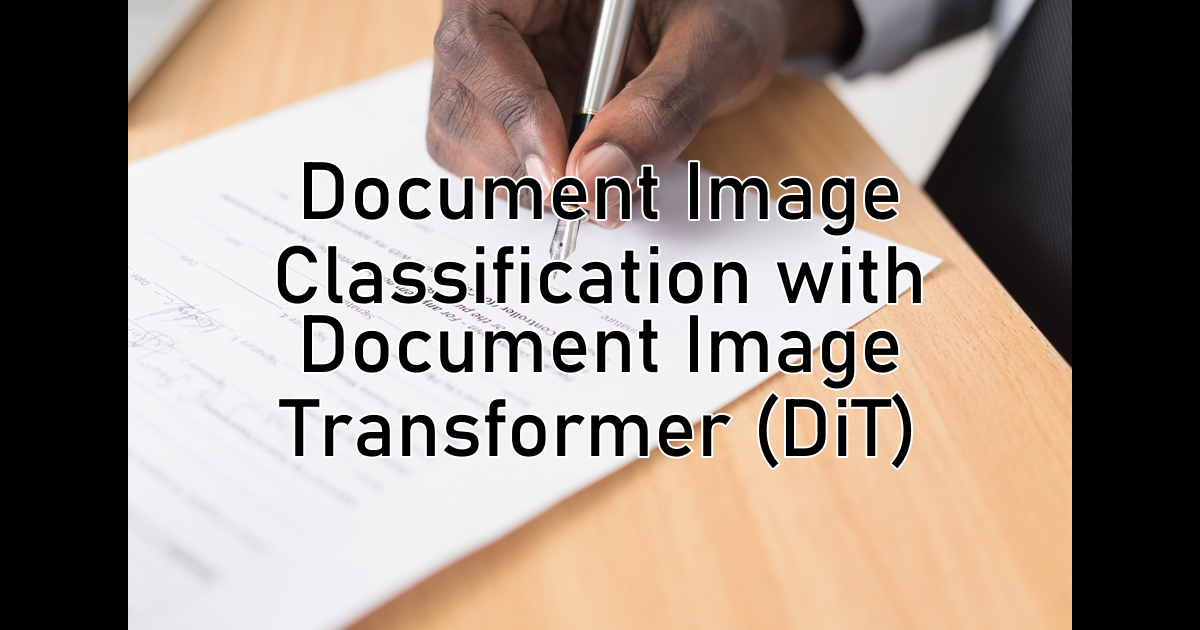tl;dr A step-by-step tutorial to automatically classify documents based on images of their contents. For example, automatically identify scientific papers or handwritten notes.
Practical Machine Learning - Learn Step-by-Step to Train a Model
A great way to learn is by going step-by-step through the process of training and evaluating the model.
Hit the Open in Colab button below to launch a Jupyter Notebook in the cloud with a step-by-step walkthrough.
Continue on if you prefer reading the code here.
Document Image Classification with Document Image Transformer (DiT)
Notebook to classify documents based on images of their contents. This task, called Document Image Classification might include classes of documents like letter, scientifica paper, form, email or resume.
The model used is a Document Image Transformer (DiT) model which is pre-trained on IIT-CDIP, a dataset that includes 42 million document images and fine-tuned on RVL-CDIP, a dataset consisting of 400,000 grayscale images in 16 classes, with 25,000 images per class.
The notebook is structured as follows:
- Setting up the Environment
- Getting Data
- Using the Model (Running Inference)
Setting up the Environment
Setting up the Dependencies
First we pip install the required dependencies. This downloads and installs the python libraries required from the PyPi repository online.
!pip install -q transformers==4.25.1 pdf2image==1.16.0
Next we use install additional libraries to allow us to work with PDF files.
!apt-get install -y poppler-utils
Reading package lists... Done
Building dependency tree
Reading state information... Done
poppler-utils is already the newest version (0.62.0-2ubuntu2.14).
The following package was automatically installed and is no longer required:
libnvidia-common-460
Use 'apt autoremove' to remove it.
0 upgraded, 0 newly installed, 0 to remove and 20 not upgraded.
Getting Data
Getting Document Images
- First we get a scientific/academic paper from OpenAI as a PDF file. Here we use
wgetto download the Whisper paper and save it aswhisper.pdf.
!wget https://cdn.openai.com/papers/whisper.pdf
--2022-12-19 08:34:23-- https://cdn.openai.com/papers/whisper.pdf
Resolving cdn.openai.com (cdn.openai.com)... 13.107.246.40, 13.107.213.40, 2620:1ec:bdf::40, ...
Connecting to cdn.openai.com (cdn.openai.com)|13.107.246.40|:443... connected.
HTTP request sent, awaiting response... 200 OK
Length: 857252 (837K) [application/pdf]
Saving to: ‘whisper.pdf’
whisper.pdf 100%[===================>] 837.16K --.-KB/s in 0.1s
2022-12-19 08:34:24 (7.69 MB/s) - ‘whisper.pdf’ saved [857252/857252]
- Next, we use the
pdf2imagelibrary to convert the PDF and the cover page (page 0) to an image which is stored in the listwhisper_pages.
from pdf2image import convert_from_path
## 100 is the size to convert the image to.
whisper_pages = convert_from_path('whisper.pdf', 100, first_page=0, last_page=1)
- Next, we use
cv2_imshow()to display this image to see our PDF cover page of the paper rendered as an image.
import numpy as np
from google.colab.patches import cv2_imshow
cv2_imshow(np.array(whisper_pages[0]))

- Great! Now let’s get a financial report from the National University of Singapore. We use
wgetonce more.
!wget https://nus.edu.sg/docs/default-source/annual-report/nus-financial-report-2022.pdf
--2022-12-19 08:45:38-- https://nus.edu.sg/docs/default-source/annual-report/nus-financial-report-2022.pdf
Resolving nus.edu.sg (nus.edu.sg)... 45.60.33.225, 45.60.35.225
Connecting to nus.edu.sg (nus.edu.sg)|45.60.33.225|:443... connected.
HTTP request sent, awaiting response... 200 OK
Length: 1536893 (1.5M) [application/pdf]
Saving to: ‘nus-financial-report-2022.pdf’
nus-financial-repor 100%[===================>] 1.46M 768KB/s in 2.0s
2022-12-19 08:45:41 (768 KB/s) - ‘nus-financial-report-2022.pdf’ saved [1536893/1536893]
- Again we use the
pdf2imagelibrary to convert the PDF and one of the pages with the actual financial report (page 6) to an image which is stored in the listnus_pages.
from pdf2image import convert_from_path
nus_pages = convert_from_path('nus-financial-report-2022.pdf', 100, first_page=6, last_page=7)
- We use
cv2_imshow()to display this image to see our PDF page of financials with a table of numbers rendered as an image.
cv2_imshow(np.array(nus_pages[0]))

Using the Model (Running Inference)
First we download and setup the model weights of the pre-trained model from the huggingface hub using the transformers library.
We download and load the dit-base-finetuned-rvlcdip model using the convenience pipeline function in the library.
from transformers import pipeline
pipe = pipeline(task="image-classification", model="microsoft/dit-base-finetuned-rvlcdip")
/usr/local/lib/python3.8/dist-packages/transformers/models/beit/image_processing_beit.py:111: FutureWarning: The `reduce_labels` parameter is deprecated and will be removed in a future version. Please use `do_reduce_labels` instead.
warnings.warn(
Now we can simply run the images that we have prepared against the pipeline to get the Document Image Classification results. First, we run the Whisper paper page image through the pipe. We see that the model is over 87% confident that this image is a scientific publication. That’s right!
output_json = pipe(whisper_pages[0])
output_json
[{'score': 0.8787207007408142, 'label': 'scientific publication'},
{'score': 0.02657017670571804, 'label': 'news article'},
{'score': 0.02074269764125347, 'label': 'scientific report'},
{'score': 0.006884910631924868, 'label': 'email'},
{'score': 0.006216561887413263, 'label': 'file folder'}]
Next we try with the NUS financial report page and viola, we get over 90% confidence that its a budget document. That’s the closest of the 16 classes and we’ve got that right too!
output_json = pipe(nus_pages[0])
output_json
[{'score': 0.9057689309120178, 'label': 'budget'},
{'score': 0.007138940971344709, 'label': 'form'},
{'score': 0.006847307551652193, 'label': 'presentation'},
{'score': 0.006752100307494402, 'label': 'advertisement'},
{'score': 0.006463303696364164, 'label': 'email'}]
You can save the images to a file using the .save() method.
nus_pages[0].save('nus_page.jpg', 'JPEG')
whisper_pages[0].save('whisper_page.jpg', 'JPEG')
We can connect to Google Drive with the following code. You can also click the Files icon on the left panel and click Mount Drive to mount your Google Drive.
The root of your Google Drive will be mounted to /content/drive/My Drive/. If you have problems mounting the drive, you can check out this tutorial.
from google.colab import drive
drive.mount('/content/drive/')
You can move the output files which are saved in the /content/ directory to the root of your Google Drive.
import shutil
shutil.move('/content/whisper_page.jpg', '/content/drive/My Drive/whisper_page.jpg')
More Notebooks @ eugenesiow/practical-ml and do star or drop us some feedback on how to improve the notebooks on the Github repo.
